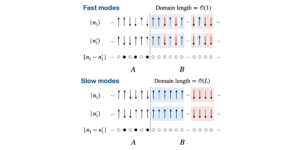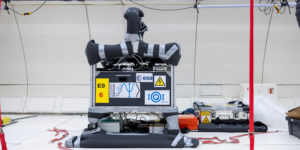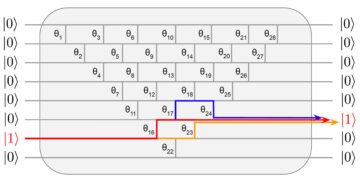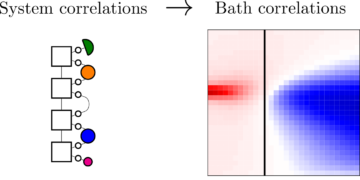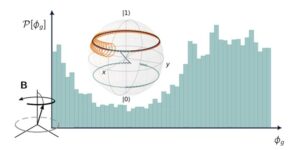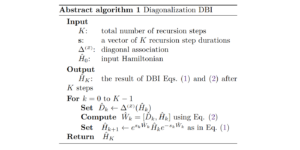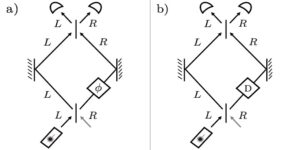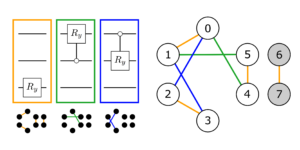1Unitary Fund
2Michigan State University, East Lansing, MI
3AWS Center for Quantum Computing, Pasadena, CA 91125, USA
4Hamburg University of Applied Sciences, Hamburg, Germany
5Theoretical Division, Los Alamos National Laboratory, Los Alamos, NM 87545, USA
6Institute for Quantum Computing, University of Waterloo, Waterloo, ON, N2L 3G1, Canada
7Instituto de Física Teórica, UAM/CSIC, Universidad Autónoma de Madrid, Madrid, Spain
8Stanford University, Palo Alto, CA
9Independent researcher
10Southern Illinois University, Carbondale, IL
11Institut quantique, Université de Sherbrooke, Sherbrooke, QC, J1K 2R1, Canada
12Goldman, Sachs & Co, New York, NY
Find this paper interesting or want to discuss? Scite or leave a comment on SciRate.
Abstract
We introduce Mitiq, a Python package for error mitigation on noisy quantum computers. Error mitigation techniques can reduce the impact of noise on near-term quantum computers with minimal overhead in quantum resources by relying on a mixture of quantum sampling and classical post-processing techniques. Mitiq is an extensible toolkit of different error mitigation methods, including zero-noise extrapolation, probabilistic error cancellation, and Clifford data regression. The library is designed to be compatible with generic backends and interfaces with different quantum software frameworks. We describe Mitiq using code snippets to demonstrate usage and discuss features and contribution guidelines. We present several examples demonstrating error mitigation on IBM and Rigetti superconducting quantum processors as well as on noisy simulators.
Featured image: Mitiq project logo
[embedded content]
Popular summary
Current quantum computers are noisy due to interactions with the environment, imperfect gate applications, state preparation and measurement errors, etc. Error mitigation seeks to reduce these effects with minimal overhead in quantum resources by relying on a mixture of quantum sampling and classical post-processing techniques.
► BibTeX data
► References
[1] Suguru Endo, Zhenyu Cai, Simon C. Benjamin, and Xiao Yuan. “Hybrid quantum-classical algorithms and quantum error mitigation”. J. Phys. Soc. Japan 90, 032001 (2021).
https://doi.org/10.7566/jpsj.90.032001
[2] Kristan Temme, Sergey Bravyi, and Jay M. Gambetta. “Error mitigation for short-depth quantum circuits”. Phys. Rev. Lett. 119, 180509 (2017).
https://doi.org/10.1103/PhysRevLett.119.180509
[3] Ying Li and Simon C. Benjamin. “Efficient variational quantum simulator incorporating active error minimization”. Phys. Rev. X 7, 021050 (2017).
https://doi.org/10.1103/PhysRevX.7.021050
[4] Suguru Endo, Simon C. Benjamin, and Ying Li. “Practical quantum error mitigation for near-future applications”. Phys. Rev. X 8, 031027 (2018).
https://doi.org/10.1103/PhysRevX.8.031027
[5] Piotr Czarnik, Andrew Arrasmith, Patrick J Coles, and Lukasz Cincio. “Error mitigation with Clifford quantum-circuit data” (2020). arXiv:2005.10189.
https://doi.org/10.22331/q-2021-11-26-592
arXiv:2005.10189
[6] Angus Lowe, Max Hunter Gordon, Piotr Czarnik, Andrew Arrasmith, Patrick J. Coles, and Lukasz Cincio. “Unified approach to data-driven quantum error mitigation” (2020). arXiv:2011.01157.
https://doi.org/10.1103/PhysRevResearch.3.033098
arXiv:2011.01157
[7] Lea F. Santos and Lorenza Viola. “Dynamical control of qubit coherence: Random versus deterministic schemes”. Phys. Rev. A 72, 062303 (2005).
https://doi.org/10.1103/PhysRevA.72.062303
[8] Lorenza Viola and Emanuel Knill. “Random decoupling schemes for quantum dynamical control and error suppression”. Phys. Rev. Lett. 94, 060502 (2005).
https://doi.org/10.1103/PhysRevLett.94.060502
[9] Bibek Pokharel, Namit Anand, Benjamin Fortman, and Daniel A. Lidar. “Demonstration of fidelity improvement using dynamical decoupling with superconducting qubits”. Phys. Rev. Lett. 121, 220502 (2018).
https://doi.org/10.1103/PhysRevLett.121.220502
[10] Joel J Wallman and Joseph Emerson. “Noise tailoring for scalable quantum computation via randomized compiling”. Phys. Rev. A 94, 052325 (2016).
https://doi.org/10.1103/PhysRevA.94.052325
[11] Jarrod R. McClean, Zhang Jiang, Nicholas C. Rubin, Ryan Babbush, and Hartmut Neven. “Decoding quantum errors with subspace expansions”. Nature Commun. 11 (2020).
https://doi.org/10.1038/s41467-020-14341-w
[12] Abhinav Kandala, Kristan Temme, Antonio D. Córcoles, Antonio Mezzacapo, Jerry M. Chow, and Jay M. Gambetta. “Error mitigation extends the computational reach of a noisy quantum processor”. Nature 567, 491–495 (2019).
https://doi.org/10.1038/s41586-019-1040-7
[13] Tudor Giurgica-Tiron, Yousef Hindy, Ryan LaRose, Andrea Mari, and William J. Zeng. “Digital zero noise extrapolation for quantum error mitigation”. 2020 IEEE Int. Conf. Quantum Comp. Eng. (QCE) (2020).
https://doi.org/10.1109/QCE49297.2020.00045
[14] Miroslav Urbanek, Benjamin Nachman, and Wibe A. de Jong. “Error detection on quantum computers improving the accuracy of chemical calculations”. Phys. Rev. A 102 (2020).
https://doi.org/10.1103/PhysRevA.102.022427
[15] Christophe Vuillot. “Is error detection helpful on IBM 5Q chips?”. Quantum Inf. Comp. 18 (2018).
https://doi.org/10.26421/qic18.11-12
[16] Google AI Quantum et al. “Hartree-Fock on a superconducting qubit quantum computer”. Science 369, 1084–1089 (2020).
https://doi.org/10.1126/science.abb9811
[17] Chao Song, Jing Cui, H. Wang, J. Hao, H. Feng, and Ying Li. “Quantum computation with universal error mitigation on a superconducting quantum processor”. Science Adv. 5 (2019).
https://doi.org/10.1126/sciadv.aaw5686
[18] Shuaining Zhang, Yao Lu, Kuan Zhang, Wentao Chen, Ying Li, Jing-Ning Zhang, and Kihwan Kim. “Error-mitigated quantum gates exceeding physical fidelities in a trapped-ion system”. Nature Communications 11, 587 (2020).
https://doi.org/10.1038/s41467-020-14376-z
[19] Alan Ho and Dave Bacon. “Announcing Cirq: An open-source framework for NISQ algorithms”. Google Blog (2018). url: ai.googleblog.com/2018/07/announcing-cirq-open-source-framework.html.
https://ai.googleblog.com/2018/07/announcing-cirq-open-source-framework.html
[20] Héctor Abraham et al. “Qiskit: An open-source framework for quantum computing” (2019).
https://doi.org/10.5281/zenodo.2562111
[21] Robert S. Smith, Michael J. Curtis, and William J. Zeng. “A practical quantum instruction set architecture” (2016). arXiv:1608.03355.
arXiv:1608.03355
[22] Braket. “https://github.com/aws/amazon-braket-sdk-python” (2021).
https://github.com/aws/amazon-braket-sdk-python
[23] Pauli Virtanen et al. “SciPy 1.0: fundamental algorithms for scientific computing in Python”. Nature Meth. 17, 261–272 (2020).
https://doi.org/10.1038/s41592-019-0686-2
[24] P. J. J. O’Malley, R. Babbush, I. D. Kivlichan, J. Romero, J. R. McClean, R. Barends, J. Kelly, P. Roushan, A. Tranter, N. Ding, and et al. “Scalable quantum simulation of molecular energies”. Physical Review X 6 (2016).
https://doi.org/10.1103/PhysRevX.6.031007
[25] Alejandro Sopena, Max Hunter Gordon, Germán Sierra, and Esperanza López. “Simulating quench dynamics on a digital quantum computer with data-driven error mitigation” (2021). arXiv:2103.12680.
https://doi.org/10.1088/2058-9565/ac0e7a
arXiv:2103.12680
[26] Zhenyu Cai. “Multi-exponential error extrapolation and combining error mitigation techniques for nisq applications”. npj Quantum Inf. 7, 80 (2021).
https://doi.org/10.1038/s41534-021-00404-3
[27] Jinzhao Sun, Xiao Yuan, Takahiro Tsunoda, Vlatko Vedral, Simon C. Benjamin, and Suguru Endo. “Mitigating realistic noise in practical noisy intermediate-scale quantum devices”. Phys. Rev. Applied 15, 034026 (2021).
https://doi.org/10.1103/PhysRevApplied.15.034026
[28] Jarrod R. McClean, Mollie E. Kimchi-Schwartz, Jonathan Carter, and Wibe A. de Jong. “Hybrid quantum-classical hierarchy for mitigation of decoherence and determination of excited states”. Phys. Rev. A 95, 042308 (2017).
https://doi.org/10.1103/PhysRevA.95.042308
[29] X. Bonet-Monroig, R. Sagastizabal, M. Singh, and T. E. O’Brien. “Low-cost error mitigation by symmetry verification”. Phys. Rev. A 98, 062339 (2018).
https://doi.org/10.1103/PhysRevA.98.062339
[30] Sam McArdle, Xiao Yuan, and Simon Benjamin. “Error-mitigated digital quantum simulation”. Phys. Rev. Lett. 122, 180501 (2019).
https://doi.org/10.1103/PhysRevLett.122.180501
[31] R. Sagastizabal, X. Bonet-Monroig, M. Singh, M. A. Rol, C. C. Bultink, X. Fu, C. H. Price, V. P. Ostroukh, N. Muthusubramanian, A. Bruno, M. Beekman, N. Haider, T. E. O’Brien, and L. DiCarlo. “Experimental error mitigation via symmetry verification in a variational quantum eigensolver”. Phys. Rev. A 100, 010302 (2019).
https://doi.org/10.1103/PhysRevA.100.010302
[32] Bálint Koczor. “Exponential error suppression for near-term quantum devices” (2021). arXiv:2011.05942.
https://doi.org/10.1103/PhysRevX.11.031057
arXiv:2011.05942
[33] William J. Huggins, Sam McArdle, Thomas E. O’Brien, Joonho Lee, Nicholas C. Rubin, Sergio Boixo, K. Birgitta Whaley, Ryan Babbush, and Jarrod R. McClean. “Virtual distillation for quantum error mitigation” (2021). arXiv:2011.07064.
https://doi.org/10.1103/PhysRevX.11.041036
arXiv:2011.07064
[34] Zhenyu Cai. “Quantum error mitigation using symmetry expansion” (2021). arXiv:2101.03151.
https://doi.org/10.22331/q-2021-09-21-548
arXiv:2101.03151
[35] Carlo Cafaro and Peter van Loock. “Approximate quantum error correction for generalized amplitude-damping errors”. Phys. Rev. A 89, 022316 (2014).
https://doi.org/10.1103/PhysRevA.89.022316
[36] Matthew Otten and Stephen K. Gray. “Recovering noise-free quantum observables”. Phys. Rev. A 99, 012338 (2019).
https://doi.org/10.1103/PhysRevA.99.012338
[37] Sisi Zhou and Liang Jiang. “Optimal approximate quantum error correction for quantum metrology”. Phys. Rev. Research 2, 013235 (2020).
https://doi.org/10.1103/PhysRevResearch.2.013235
[38] Ming Gong, Xiao Yuan, Shiyu Wang, Yulin Wu, Youwei Zhao, Chen Zha, Shaowei Li, Zhen Zhang, Qi Zhao, Yunchao Liu, Futian Liang, Jin Lin, Yu Xu, Hui Deng, Hao Rong, He Lu, Simon C Benjamin, Cheng-Zhi Peng, Xiongfeng Ma, Yu-Ao Chen, Xiaobo Zhu, and Jian-Wei Pan. “Experimental exploration of five-qubit quantum error-correcting code with superconducting qubits”. National Science Review 9 (2021).
https://doi.org/10.1093/nsr/nwab011
[39] Philipp Schindler, Julio T. Barreiro, Thomas Monz, Volckmar Nebendahl, Daniel Nigg, Michael Chwalla, Markus Hennrich, and Rainer Blatt. “Experimental repetitive quantum error correction”. Science 332, 1059 (2011).
https://doi.org/10.1126/science.1203329
[40] E. Knill. “Quantum computing with realistically noisy devices”. Nature 434, 39 (2005).
https://doi.org/10.1038/nature03350
[41] Constantin Brif, Raj Chakrabarti, and Herschel Rabitz. “Control of quantum phenomena: past, present and future”. New J. Phys. 12, 075008 (2010).
https://doi.org/10.1088/1367-2630/12/7/075008
[42] Lorenza Viola, Emanuel Knill, and Seth Lloyd. “Dynamical decoupling of open quantum systems”. Phys. Rev. Lett. 82, 2417 (1999).
https://doi.org/10.1103/physrevlett.82.2417
[43] Harrison Ball, Michael J Biercuk, Andre R R Carvalho, Jiayin Chen, Michael Hush, Leonardo A De Castro, Li Li, Per J Liebermann, Harry J Slatyer, Claire Edmunds, Virginia Frey, Cornelius Hempel, and Alistair Milne. “Software tools for quantum control: improving quantum computer performance through noise and error suppression”. Quantum Science and Technology 6, 044011 (2021).
https://doi.org/10.1088/2058-9565/abdca6
[44] Howard J. Carmichael. “Statistical methods in quantum optics 1: Master equations and fokker-planck equations”. Springer-Verlag. (1999).
https://doi.org/10.1007/978-3-662-03875-8
[45] H.J. Carmichael. “Statistical methods in quantum optics 2: Non-classical fields”. Springer Berlin Heidelberg. (2007).
https://doi.org/10.1007/978-3-540-71320-3
[46] H.P. Breuer and F. Petruccione. “The theory of open quantum systems”. OUP Oxford. (2007).
https://doi.org/10.1093/acprof:oso/9780199213900.001.0001
[47] Prakash Murali, David C. Mckay, Margaret Martonosi, and Ali Javadi-Abhari. “Software mitigation of crosstalk on noisy intermediate-scale quantum computers”. Proc. Twenty-Fifth Int. Conf. on Architect. Supp. for Progr. Lang. Operat. Syst. (2020).
https://doi.org/10.1145/3373376.3378477
[48] Iulia Buluta, Sahel Ashhab, and Franco Nori. “Natural and artificial atoms for quantum computation”. Rep. Progr. Phys. 74, 104401 (2011).
https://doi.org/10.1088/0034-4885/74/10/104401
[49] Henrique Silvério, Sebastián Grijalva, Constantin Dalyac, Lucas Leclerc, Peter J. Karalekas, Nathan Shammah, Mourad Beji, Louis-Paul Henry, and Loïc Henriet. “Pulser: An open-source package for the design of pulse sequences in programmable neutral-atom arrays” (2021). arXiv:2104.15044.
https://doi.org/10.22331/q-2022-01-24-629
arXiv:2104.15044
[50] Boxi Li, Shahnawaz Ahmed, Sidhant Saraogi, Neill Lambert, Franco Nori, Alexander Pitchford, and Nathan Shammah. “Pulse-level noisy quantum circuits with QuTiP” (2021). arXiv:2105.09902.
https://doi.org/10.22331/q-2022-01-24-630
arXiv:2105.09902
[51] Daniel Gottesman, Alexei Kitaev, and John Preskill. “Encoding a qubit in an oscillator”. Phys. Rev. A 64, 012310 (2001).
https://doi.org/10.1103/PhysRevA.64.012310
[52] Mazyar Mirrahimi, Zaki Leghtas, Victor V Albert, Steven Touzard, Robert J Schoelkopf, Liang Jiang, and Michel H Devoret. “Dynamically protected cat-qubits: a new paradigm for universal quantum computation”. New J. Phys. 16, 045014 (2014).
https://doi.org/10.1088/1367-2630/16/4/045014
[53] Marios H. Michael, Matti Silveri, R. T. Brierley, Victor V. Albert, Juha Salmilehto, Liang Jiang, and S. M. Girvin. “New class of quantum error-correcting codes for a bosonic mode”. Phys. Rev. X 6, 031006 (2016).
https://doi.org/10.1103/PhysRevX.6.031006
[54] Victor V. Albert, Jacob P. Covey, and John Preskill. “Robust encoding of a qubit in a molecule”. Physical Review X 10 (2020).
https://doi.org/10.1103/physrevx.10.031050
[55] Jeffrey M. Gertler, Brian Baker, Juliang Li, Shruti Shirol, Jens Koch, and Chen Wang. “Protecting a bosonic qubit with autonomous quantum error correction”. Nature 590, 243 (2021).
https://doi.org/10.1038/s41586-021-03257-0
[56] D. A. Lidar, I. L. Chuang, and K. B. Whaley. “Decoherence-free subspaces for quantum computation”. Phys. Rev. Lett. 81, 2594 (1998).
https://doi.org/10.1103/PhysRevLett.81.2594
[57] Emanuel Knill, Raymond Laflamme, and Lorenza Viola. “Theory of quantum error correction for general noise”. Phys. Rev. Lett. 84, 2525–2528 (2000).
https://doi.org/10.1103/PhysRevLett.84.2525
[58] Anton Frisk Kockum, Göran Johansson, and Franco Nori. “Decoherence-free interaction between giant atoms in waveguide quantum electrodynamics”. Phys. Rev. Lett. 120, 140404 (2018).
https://doi.org/10.1103/PhysRevLett.120.140404
[59] Simon Lieu, Ron Belyansky, Jeremy T. Young, Rex Lundgren, Victor V. Albert, and Alexey V. Gorshkov. “Symmetry breaking and error correction in open quantum systems”. Phys. Rev. Lett. 125, 240405 (2020).
https://doi.org/10.1103/physrevlett.125.240405
[60] Thomas A Alexander, Naoki Kanazawa, Daniel Josef Egger, Lauren Capelluto, Christopher James Wood, Ali Javadi-Abhari, and David McKay. “Qiskit-Pulse: programming quantum computers through the cloud with pulses”. Quantum Sci. Tech. 5, 044006 (2020).
https://doi.org/10.1088/2058-9565/aba404
[61] Peter J Karalekas, Nikolas A Tezak, Eric C Peterson, Colm A Ryan, Marcus P da Silva, and Robert S Smith. “A quantum-classical cloud platform optimized for variational hybrid algorithms”. Quantum Sci. Tech. 5, 024003 (2020).
https://doi.org/10.1088/2058-9565/ab7559
Cited by
[1] Kaoru Yamamoto, Suguru Endo, Hideaki Hakoshima, Yuichiro Matsuzaki, and Yuuki Tokunaga, “Error-mitigated quantum metrology via virtual purification”, arXiv:2112.01850.
[2] Gokul Subramanian Ravi, Kaitlin N. Smith, Pranav Gokhale, Andrea Mari, Nathan Earnest, Ali Javadi-Abhari, and Frederic T. Chong, “VAQEM: A Variational Approach to Quantum Error Mitigation”, arXiv:2112.05821.
[3] Andrew Eddins, Mario Motta, Tanvi P. Gujarati, Sergey Bravyi, Antonio Mezzacapo, Charles Hadfield, and Sarah Sheldon, “Doubling the Size of Quantum Simulators by Entanglement Forging”, PRX Quantum 3 1, 010309 (2022).
[4] Andrea Mari, Nathan Shammah, and William J. Zeng, “Extending quantum probabilistic error cancellation by noise scaling”, Physical Review A 104 5, 052607 (2021).
[5] Alejandro Sopena, Max Hunter Gordon, Germán Sierra, and Esperanza López, “Simulating quench dynamics on a digital quantum computer with data-driven error mitigation”, Quantum Science and Technology 6 4, 045003 (2021).
[6] Michael Krebsbach, Björn Trauzettel, and Alessio Calzona, “Optimization of Richardson extrapolation for quantum error mitigation”, arXiv:2201.08080.
[7] Yongxin Yao, Feng Zhang, Cai-Zhuang Wang, Kai-Ming Ho, and Peter P. Orth, “Gutzwiller hybrid quantum-classical computing approach for correlated materials”, Physical Review Research 3 1, 013184 (2021).
[8] Emilie Huffman, Miguel García Vera, and Debasish Banerjee, “Real-time dynamics of Plaquette Models using NISQ Hardware”, arXiv:2109.15065.
[9] Samuele Ferracin, Akel Hashim, Jean-Loup Ville, Ravi Naik, Arnaud Carignan-Dugas, Hammam Qassim, Alexis Morvan, David I. Santiago, Irfan Siddiqi, and Joel J. Wallman, “Efficiently improving the performance of noisy quantum computers”, arXiv:2201.10672.
[10] Alejandro Sopena, Max Hunter Gordon, Diego García-Martín, Germán Sierra, and Esperanza López, “Algebraic Bethe Circuits”, arXiv:2202.04673.
[11] Boxi Li, Shahnawaz Ahmed, Sidhant Saraogi, Neill Lambert, Franco Nori, Alexander Pitchford, and Nathan Shammah, “Pulse-level noisy quantum circuits with QuTiP”, arXiv:2105.09902.
[12] Martin Rodriguez-Vega, Ella Carlander, Adrian Bahri, Ze-Xun Lin, Nikolai A. Sinitsyn, and Gregory A. Fiete, “Real-time simulation of light-driven spin chains on quantum computers”, Physical Review Research 4 1, 013196 (2022).
[13] Noah F. Berthusen, Thaís V. Trevisan, Thomas Iadecola, and Peter P. Orth, “Quantum dynamics simulations beyond the coherence time on noisy intermediate-scale quantum hardware by variational Trotter compression”, Physical Review Research 4 2, 023097 (2022).
[14] José D. Guimarães, Mikhail I. Vasilevskiy, and Luís S. Barbosa, “Efficient method to simulate non-perturbative dynamics of an open quantum system using a quantum computer”, arXiv:2203.14653.
[15] Almudena Carrera Vazquez, Daniel J. Egger, David Ochsner, and Stefan Woerner, “Well-conditioned multi-product formulas for hardware-friendly Hamiltonian simulation”, arXiv:2207.11268.
[16] Cristina Cirstoiu, Silas Dilkes, Daniel Mills, Seyon Sivarajah, and Ross Duncan, “Volumetric Benchmarking of Error Mitigation with Qermit”, arXiv:2204.09725.
[17] Anirban Mukherjee, Noah F. Berthusen, João C. Getelina, Peter P. Orth, and Yong-Xin Yao, “Comparative study of adaptive variational quantum eigensolvers for multi-orbital impurity models”, arXiv:2203.06745.
[18] Ryan LaRose, Andrea Mari, Vincent Russo, Dan Strano, and William J. Zeng, “Error mitigation increases the effective quantum volume of quantum computers”, arXiv:2203.05489.
[19] Matteo Paltenghi and Michael Pradel, “Bugs in Quantum Computing Platforms: An Empirical Study”, arXiv:2110.14560.
[20] Olivia Di Matteo and R. M. Woloshyn, “Quantum computing fidelity susceptibility using automatic differentiation”, arXiv:2207.06526.
[21] Changsu Cao, Jiaqi Hu, Wengang Zhang, Xusheng Xu, Dechin Chen, Fan Yu, Jun Li, Hanshi Hu, Dingshun Lv, and Man-Hong Yung, “Towards a Larger Molecular Simulation on the Quantum Computer: Up to 28 Qubits Systems Accelerated by Point Group Symmetry”, arXiv:2109.02110.
[22] Vasily Sazonov and Mohamed Tamaazousti, “Quantum error mitigation for parametric circuits”, Physical Review A 105 4, 042408 (2022).
[23] Changsu Cao, Jiaqi Hu, Wengang Zhang, Xusheng Xu, Dechin Chen, Fan Yu, Jun Li, Han-Shi Hu, Dingshun Lv, and Man-Hong Yung, “Progress toward larger molecular simulation on a quantum computer: Simulating a system with up to 28 qubits accelerated by point-group symmetry”, Physical Review A 105 6, 062452 (2022).
[24] Swarnadeep Majumder, Christopher G. Yale, Titus D. Morris, Daniel S. Lobser, Ashlyn D. Burch, Matthew N. H. Chow, Melissa C. Revelle, Susan M. Clark, and Raphael C. Pooser, “Characterizing and mitigating coherent errors in a trapped ion quantum processor using hidden inverses”, arXiv:2205.14225.
[25] Olivia Di Matteo, Josh Izaac, Tom Bromley, Anthony Hayes, Christina Lee, Maria Schuld, Antal Száva, Chase Roberts, and Nathan Killoran, “Quantum computing with differentiable quantum transforms”, arXiv:2202.13414.
[26] Kevin Schultz, Ryan LaRose, Andrea Mari, Gregory Quiroz, Nathan Shammah, B. David Clader, and William J. Zeng, “Reducing the impact of time-correlated noise on zero-noise extrapolation”, arXiv:2201.11792.
[27] John Rogers, Gargee Bhattacharyya, Marius S. Frank, Tao Jiang, Ove Christiansen, Yong-Xin Yao, and Nicola Lanatà, “Error mitigation in variational quantum eigensolvers using probabilistic machine learning”, arXiv:2111.08814.
[28] Yi Fan, Jie Liu, Zhenyu Li, and Jinlong Yang, “A Quantum Algorithm to Calculate Band Structure at the EOM Level of Theory”, arXiv:2109.01318.
[29] Cheng-Lin Hong, Ting Tsai, Jyh-Pin Chou, Peng-Jen Chen, Pei-Kai Tsai, Yu-Cheng Chen, En-Jui Kuo, David Srolovitz, Alice Hu, Yuan-Chung Cheng, and Hsi-Sheng Goan, “Accurate and Efficient Quantum Computations of Molecular Properties Using Daubechies Wavelet Molecular Orbitals: A Benchmark Study against Experimental Data”, PRX Quantum 3 2, 020360 (2022).
The above citations are from SAO/NASA ADS (last updated successfully 2022-08-12 00:20:22). The list may be incomplete as not all publishers provide suitable and complete citation data.
On Crossref’s cited-by service no data on citing works was found (last attempt 2022-08-12 00:20:20).
This Paper is published in Quantum under the Creative Commons Attribution 4.0 International (CC BY 4.0) license. Copyright remains with the original copyright holders such as the authors or their institutions.



